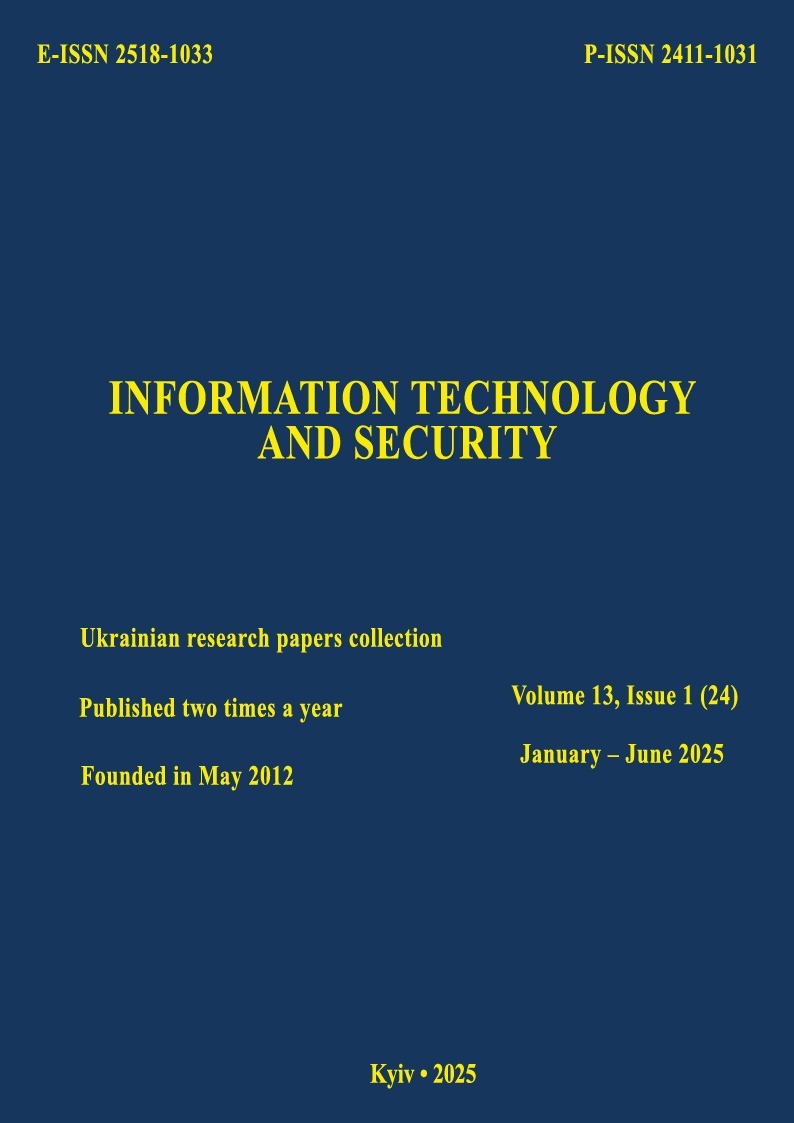Impact of redundancy on the security of technical information leakage channels and approximate correction of the channel error probability
DOI:
https://doi.org/10.20535/2411-1031.2025.13.1.328982Keywords:
redundancy, error probability, correction codes, information security, optimal reception, Hamming code, information and communication systemsAbstract
The article considers the impact of redundancy on the security of technical information leakage channels and the approximate correction of the error probability in the channel in the absence of information about the origin of redundancy. The mechanisms of introducing redundancy into signals are investigated, which contribute to improving noise immunity by correcting errors, but also create risks of reducing the confidentiality of transmitted information. The article considers two main types of redundancy: artificial, which is formed through coding and control characters, and natural, which is a consequence of the peculiarities of the information source. The principles of its decoding differ significantly. This makes it impossible to directly apply error probability correction methods developed for artificial redundancy to natural redundancy. Artificial redundancy has a clear structure and is used to increase noise immunity, while natural redundancy arises from the characteristics of the information source, manifesting itself through correlations between symbols, repeated patterns and statistical regularities. The article considers the features of speech and visual channels, where natural redundancy plays a key role in error correction. In speech channels, it helps to increase the reliability of information reception due to the subjectivity of pronunciation and perception, and in visual channels - due to the regularity of pixel distribution in images. A new approach to decoding based on the ordering of code combinations by weight is proposed. The method of dividing possible 7-bit combinations into groups is used, which provides more efficient error correction. The traditional approach to error correction in the Hamming (7,4) code and its limitations at high levels of interference are also considered. The results obtained can be used to improve methods of increasing the reliability of data transmission and reducing the risks of information leakage through technical channels. Importantly, this method not only improves error correction, but also opens up new opportunities for adaptive coding in complex information transmission conditions. Its versatility makes it possible to apply the approach in various fields, from digital communications to speech signal processing.
References
S. Ivanchenko, O. Havrylenko, O. Lipsky, and A. Shevtsov, Technical channels of information leakage. The procedure for creating complexes of technical protection of information. Kyiv, Ukraine: ISCIP “KPI”, 2015.
P. Upadhyaya, “When Machine Learning Meets Information Theory: Some Practical Applications to Data Storage”, PhD dissertation, Texas A&M University, College Station, TX, USA, 2020.
T. Gruber, S. Cammerer, J. Hoydis, and S. Ten Brink, “On deep learning-based channel decoding”, in Proc. 51st Ann. Con. on Inf. Scien. and Sys. (CISS), Baltimore, MD, USA, pp. 16, 2017, doi: https://doi.org/10.1109/CISS.2017.7926071.
P. Upadhyaya, and A. Jiang, “Machine Learning for Error Correction with Natural Redundancy,” arXiv (Cornell University), 2019, doi: https://doi.org/10.48550/arXiv.1910.07420.
O. Nikulina, V. Severyn, and V. Sharov, “Development of a model of interference-resistant data transmission for information technology of control optimization of dynamic systems”, Bull. of NTU “KhPI”. Series: Sys. An., Cont. and In. Tec., iss. 2 (8), pp. 57-62, 2023, doi: https://doi.org/10.20998/2079-0023.2022.02.09.
S.P. Liventsev, and G.D. Sozonnik, “Method of adaptive control of the process of decoding turbo-like codes”, in Proc. 18th Int. Sci. and Tec. Conf. Telecommunications prospects, Kyiv, 2024, pp. 35-39. [Online]. Available: https://its.kpi.ua/sites/default/files/NDI%20TK%202021/Конференція%20ПТ/Збірники%20ПТ/Збірник%20матеріалів%20конференції%20ПТ%202024%20ISSN%20р.pdf. Accessed on: Jan. 10, 2025.
Y.M. Boyko, A.I. Semenko, and I.S. Pyatin, “Features of the formation of code redundancy in information transmission channels”, Infocom. and Comp. Tec., vol. 2, iss. 04, pp. 12-25, 2023, doi: https://doi.org/10.36994/2788-5518-2022-02-04-01.
I.R. Tsymbaliuk, “Methods and means of increasing the reliability of radio signal reception using neural networks”, PhD thesis, Lviv Polytechnic Nat. Univ., Lviv, 2024. [Online]. Available: https://lpnu.ua/sites/default/files/2024/radaphd/27733/disertaciya-cimbalyukrev1.pdf. Accessed on: Feb. 12, 2025.
O.I. Yevdochenko, “Features of multi-position Reed-Solomon codes”, in Proc.10th All-Ukr. Sci. and Prac. Conf. Electronic and Mechatronic Systems: Theory, Innovation, Practice, Poltava, pp. 106-107. [Online]. Available: https://nupp.edu.ua/uploads/files/0/events/conf/2024/x-emst/zbirnik-naukovikh-prac-X-vsekrainskoi-konferencii-ems_2.pdf. Accessed on: Jan. 10, 2025.
S.V. Ilyin, E.L. Kholod, and A.B. Maznichko, “Organisation of long-term access to authentic documents”, in Proc. 2d Int. Sci. Pract. Conf. Creation of new ideas of learning in modern conditions, Bordeaux, 2023, pp. 252-258. [Online]. Available: https://dspace.hnpu.edu.ua/server/api/core/bitstreams/a8627c6c-02af-400e-ab134ea4c073c4e3/content. Accessed on: Jan. 10, 2025.
Downloads
Published
How to Cite
Issue
Section
License
Copyright (c) 2025 Collection "Information Technology and Security"

This work is licensed under a Creative Commons Attribution 4.0 International License.
The authors that are published in this collection, agree to the following terms:
- The authors reserve the right to authorship of their work and pass the collection right of first publication this work is licensed under the Creative Commons Attribution License, which allows others to freely distribute the published work with the obligatory reference to the authors of the original work and the first publication of the work in this collection.
- The authors have the right to conclude an agreement on exclusive distribution of the work in the form in which it was published this anthology (for example, to place the work in a digital repository institution or to publish in the structure of the monograph), provided that references to the first publication of the work in this collection.
- Policy of the journal allows and encourages the placement of authors on the Internet (for example, in storage facilities or on personal web sites) the manuscript of the work, prior to the submission of the manuscript to the editor, and during its editorial processing, as it contributes to productive scientific discussion and positive effect on the efficiency and dynamics of citations of published work (see The Effect of Open Access).

